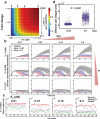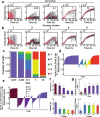Mathematical model identifies effective P53 accumulation with target gene binding affinity in DNA damage response for cell fate decision
- PMID: 30488759
- PMCID: PMC6343702
- DOI: 10.1080/15384101.2018.1553342
Mathematical model identifies effective P53 accumulation with target gene binding affinity in DNA damage response for cell fate decision
Abstract
Functional p53 signaling is essential for appropriate responses to diverse stimuli. P53 dynamics employs the information from the stimulus leading to selective gene expression and cell fate decision. However, the decoding mechanism of p53 dynamics under DNA damage challenge remains poorly understood. Here we mathematically modeled the recently dual-phase p53 dynamics under doxorubicin treatment. We found that p53 could perform sequential pulses followed by a high-amplitude terminal pulse at relatively low doxorubicin treatment, whereas p53 became steadily accumulated when damage level was high. The effective p53 integral above a threshold but not the absolute accumulation of p53 precisely discriminated survival and death. Silencing negative regulators in p53 network might promote the occurrence of terminal pulse. Furthermore, lower binding affinity and degradation rate of p53 target genes could favorably discriminate high and low dose doxorubicin treatment. Grouping by temporal profiles suggested that the p53 dynamics rather than the doxorubicin doses could better discriminate cellular outcomes and confer less variation for effective p53 integral reemphasizing the importance of p53 level regulation. Our model has established a theoretical framework that p53 dynamics can work cooperatively with its binding affinity to target genes leading to cell fate choice, providing new clues of optimized clinical design by manipulating p53 dynamics.
Keywords: DNA damage; P53 terminal pulse; cell fate decision.
Figures






Similar articles
-
p53 dynamics orchestrates with binding affinity to target genes for cell fate decision.Cell Death Dis. 2017 Oct 19;8(10):e3130. doi: 10.1038/cddis.2017.492. Cell Death Dis. 2017. PMID: 29048401 Free PMC article.
-
Dynamics of P53 in response to DNA damage: Mathematical modeling and perspective.Prog Biophys Mol Biol. 2015 Nov;119(2):175-82. doi: 10.1016/j.pbiomolbio.2015.08.017. Epub 2015 Aug 13. Prog Biophys Mol Biol. 2015. PMID: 26278643 Review.
-
p53 dynamics control cell fate.Science. 2012 Jun 15;336(6087):1440-4. doi: 10.1126/science.1218351. Science. 2012. PMID: 22700930 Free PMC article.
-
c-ABL tyrosine kinase modulates p53-dependent p21 induction and ensuing cell fate decision in response to DNA damage.Cell Signal. 2014 Feb;26(2):444-52. doi: 10.1016/j.cellsig.2013.10.005. Epub 2013 Oct 28. Cell Signal. 2014. PMID: 24177958
-
Mathematical Modeling of p53 Pathways.Int J Mol Sci. 2019 Oct 18;20(20):5179. doi: 10.3390/ijms20205179. Int J Mol Sci. 2019. PMID: 31635420 Free PMC article. Review.
Cited by
-
Skin immunity and its dysregulation in psoriasis.Cell Cycle. 2019 Oct;18(20):2581-2589. doi: 10.1080/15384101.2019.1653099. Epub 2019 Aug 15. Cell Cycle. 2019. PMID: 31416396 Free PMC article. Review.
-
Determinants of p53 DNA binding, gene regulation, and cell fate decisions.Cell Death Differ. 2024 Jul;31(7):836-843. doi: 10.1038/s41418-024-01326-1. Epub 2024 Jun 29. Cell Death Differ. 2024. PMID: 38951700 Free PMC article. Review.
References
-
- Sims RJ 3rd, Reinberg D.. Is there a code embedded in proteins that is based on post-translational modifications? Nat Rev Mol Cell Biol. 2008;9(10):815–820. - PubMed
-
- Vishwanath S, Sukhwal A, Sowdhamini R, et al. Specificity and stability of transient protein-protein interactions. Curr Opin Struct Biol. 2017;44:77–86. - PubMed
Publication types
MeSH terms
Substances
LinkOut - more resources
Full Text Sources
Other Literature Sources
Research Materials
Miscellaneous
